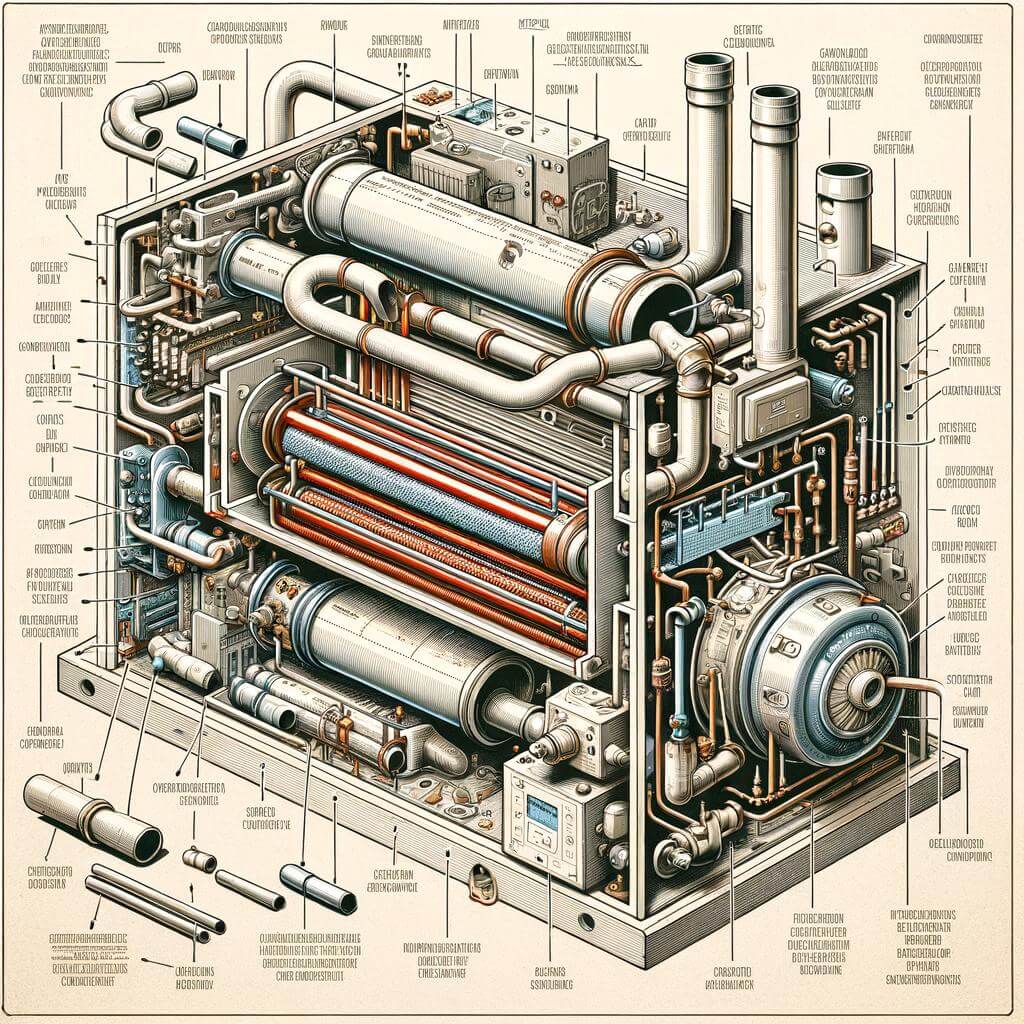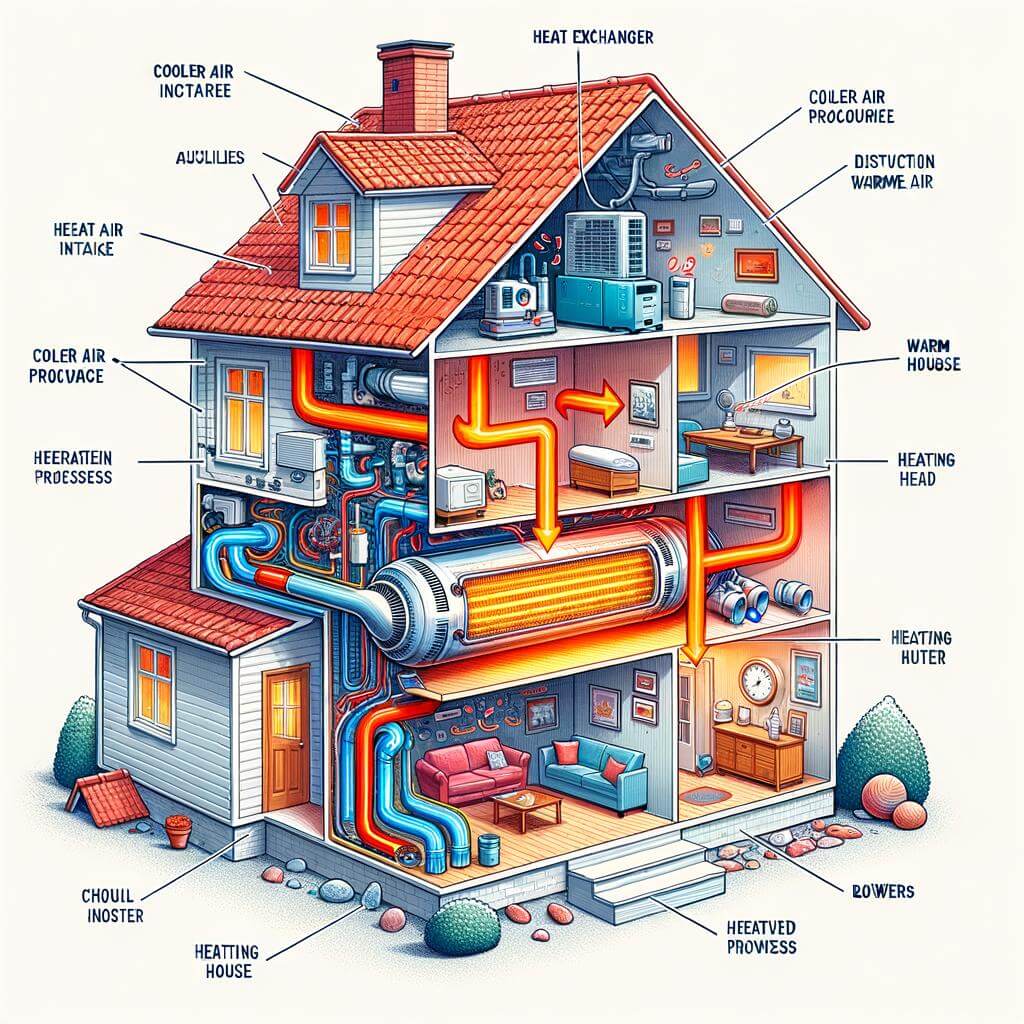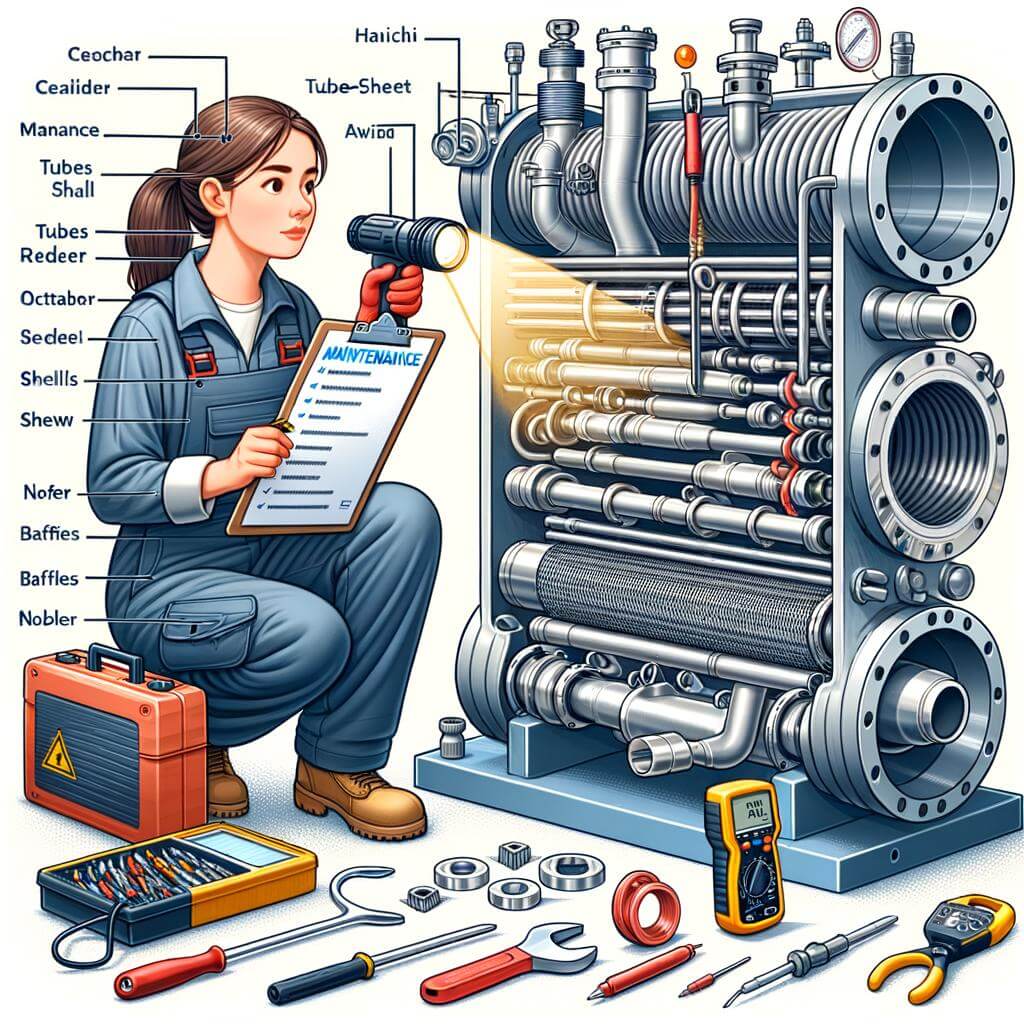Welcome! Today, we’re shining a light on a critical component of your home heating system: the heat exchanger. This often-overlooked part plays a vital role in ensuring your home remains at the ideal temperature during those chilly months. This article will deepen your understanding of the function, importance, and impact of heat exchangers in home heating systems. Armed with this knowledge, you’ll be better equipped to maintain a warm, comfortable and energy-efficient environment in your home. Whether you are a curious homeowner or a heating systems student, this post has something just for you. Let us delve into the fascinating world of heat exchangers.
An Introduction to Heat Exchangers in Home Heating Systems
How does a heat exchanger work?
Since it’s all about the transfer of heat, initially, your furnace ignites the burner, which then generates hot gases. These hot gases move through a series of tubes in the heat exchanger. As the hot gas passes through these tubes, it transfers its heat to the metal walls of the tubes. Simultaneously on the other side of these tubes, the cooler return air from your home is blown across. This process warms up the air that is then pumped back into your home.
| Part | Function |
|---|---|
| Burner | Ignites to generate hot gases |
| Series of Tubes | Allows hot gas to pass through and transfer heat to their outer surface |
| Blower | Pushes cool return air from your home across the exterior of the tubes |
Essentially, the duration for which the air remains in contact with the heat exchanger and the temperature of the hot gases are the two key factors that determine the amount of heat transferred. With the right blend of these two variables, your home can experience the desired level of warmth.

The Functionality of Heat Exchangers in Your Home
While you may not think twice about the temperature maintaining systems operating silently in the background, they play an integral role in maintaining comfort in your home. Heat exchangers are one such vital component. Often hidden within the furnace, a heat exchanger transfers heat from one medium to another, thereby warming your home efficiently and safely. Depending on the type of system you have installed at home, the heat transfer process may involve water, air, or refrigerant.
There are several types of heat exchangers that can be fitted in a residential heating system. The shell and tube heat exchanger is the most common, where one fluid runs through tubes and another in a shell around them. The plate/fin heat exchanger uses layers of metal plates and finned chambers, allowing for efficient heat exchange. The regenerative heat exchanger uses the same fluid for heating and cooling, making it an economical choice. Lastly, the adiabatic wheel heat exchanger rotates between the hot and cold fluids, transferring heat as it does.
- Shell and tube heat exchanger – most common in homes.
- Plate/fin heat exchanger – efficient heat exchange using metal plates and fined chambers.
- Regenerative heat exchanger - economical choice using the same fluid for heating and cooling.
- Adiabatic wheel heat exchanger – rotates between hot and cold fluids, transferring heat.
| Type of Heat Exchanger | Primary Usage |
|---|---|
| Shell and Tube | Commonly used in homes for general heating |
| Plate/Fin | Preferred when efficient heat exchange is required |
| Regenerative | Best for budget-conscious homeowners |
| Adiabatic wheel | Optimal for fluctuating heat demands |
In summary, the type of heat exchanger in your system influences the efficiency and cost-effectiveness of your home’s heating. Whether it’s the commonly used shell and tube or the economical regenerative model, each type has its advantages and plays an essential role in maintaining a pleasant environment at home.

Efficiency of Heat Exchangers in Optimal Heating
Heat exchangers are the unsung heroes of your home’s heating system. Whether it’s a chilly winter morning or a cool summer evening, these efficient devices work tirelessly to provide a comfortable indoor climate. Heat exchangers play a significant role in conserving energy, thereby optimizing your heating system’s functioning and leading to substantial savings on utility bills.
Heat exchangers operate on a simple principle: they transfer heat from one medium to another. For example, in a gas heating system, the heat exchanger extracts heat from the combustion gases and transfers it to the air from your home. The heated air is then circulated throughout your household. But why are heat exchangers so crucial for optimal heating?
-
Energy Efficiency: High-quality heat exchangers can recover up to 90% of the heat energy from the combustion gases. This means only a minimum amount of energy is wasted, making your heating system incredibly efficient.
-
Environmentally Friendly: By recycling heat and reducing energy waste, heat exchangers contribute to a lower carbon footprint, making your home more environmentally friendly.
-
Savings on Utilities: The more efficient your heating system is, the less fuel it uses which can translate to significant savings on your monthly utility bills.
-
Comfort: Well-functioning heat exchangers can consistently deliver warm, comfortable air all throughout your home.
| Types of Heat Exchangers | Home Heating System Application |
|---|---|
| Plate Heat Exchanger | Generally used in radiant floor heating systems |
| Shell and Tube Heat Exchanger | Widely used in central heating systems |
| Fin Tube Heat Exchanger | Often found in older style hot water baseboard systems |
Therefore, understanding the role and efficiency of heat exchangers can help optimize your home’s heating system. An efficient heating system doesn’t just make your home cozier; it also brings savings, and is beneficial to the environment.

Implementing Heat Exchangers for Economic and Environmental Benefit
Heating systems in our homes often account for a significant portion of our energy bills, especially during extreme weather conditions. An efficient solution to reduce these costs while ensuring optimal heating is the use of heat exchangers. Simply put, a heat exchanger is a device that transfers heat from one medium to another without allowing them to mix. It plays an integral part in home heating systems, making your living space comfortable while ensuring economic and environmental benefits.
- Economic benefit: Heat exchangers are designed for optimal and efficient heat transfer, which translates to lower energy consumption. Less energy used means cheaper energy bills, providing homeowners with significant savings over time.
- Environmental benefit: By reducing energy usage, heat exchangers also contribute to lowering the emission of harmful greenhouse gases. This makes them an eco-friendly choice for modern home heating systems.
| Energy Efficiency | High |
| Longevity | Long-lasting with proper maintenance |
| Environmental Impact | Low |
| Cost Savings | Significant |
This table summarizes some of the key features and benefits of installing a heat exchanger in your home heating system. In addition to these advantages, heat exchangers also require less maintenance and last a long time, especially when compared to conventional heating systems. As a result, homeowners not only save on their monthly energy bills but also on maintenance and replacement costs. All of these factors combined make heat exchangers not just a practical and economical choice, but also a step toward a greener and more sustainable lifestyle.

Maintenance and Troubleshooting Tips for Heat Exchangers
Heat exchangers play a crucial role in home heating systems, keeping your home cozy and warm even on the harshest winter days. These vital components work by transferring heat from one fluid to another without allowing them to mix. Over time, however, your heat exchanger can face wear and tear, leading to decreased efficiency and even malfunction. Yet, with a proactive approach and an understanding of their operation, you can mitigate these issues before they evolve into major problems.
Regular Maintenance Tips
- Periodic Cleaning: One of the best ways to keep your heat exchanger up and running efficiently is through regular cleaning. Dirt and soot can build up over time, reducing the system’s ability to transfer heat effectively. Therefore, make sure to clean the heat exchanger surface periodically to prevent this buildup.
- Inspection for Damage: Damage to the heat exchanger can lead to inefficiencies and potentially hazardous conditions. Therefore, it is essential to regularly inspect your heat exchanger for any visible signs of wear and tear, cracks, or damage.
- Professional Maintenance Visit: It is recommended to schedule a professional maintenance visit at least once a year. A professional technician will be able to thoroughly inspect, clean, and if necessary, repair your heat exchanger to ensure optimum functionality.
Troubleshooting Common Problems
| Problem | Solution |
|---|---|
| Reduced Heat Transfer | Check for buildup on the heat exchanger surface and clean thoroughly. Make sure the fluid is flowing correctly. If not, check the pump or other mechanical elements. |
| Visible Cracks or Damage | Call a professional for an inspection. A cracked heat exchanger can be dangerous as it may allow combustion gases to enter your home. |
| Noise during Operation | This could indicate a mechanical issue with the system. Seek professional help. |
Effective maintenance and troubleshooting of your heat exchanger can ensure long-lasting, efficient operation, keeping your home warm and your heating costs down.
Upgrade Recommendations: Choosing the Right Heat Exchanger for Your Home
Heat exchangers are an integral part of your home heating system. Picture them as the heart of your heating system, driving heat from one source to another. In their most basic form, heat exchangers work by transferring energy (in this case heat) from one medium to another. This is accomplished through phases of heating and cooling, which are executed through a series of tubes or plates.
Upgrading your heat exchanger can bring about a notable increase in the efficiency and performance of your home heating system. As the market is packed with a myriad of options, here are some factors you should consider while choosing the heat exchanger tailored for your needs:
- Material: The exchanger’s material directly affects its longevity and effectiveness. Commonly used materials include stainless steel, titanium, and carbon steel. Stainless steel is generally known for its high durability, while titanium offers exceptional heat transfer capabilities.
- Size: It’s crucial to pick a heat exchanger that fits well within the allotted space of your heating system. This not only ensures seamless installation but also results in optimal performance.
- Heat Transfer Capability: The primary function of a heat exchanger is transferring heat, and thus, this factor is of utmost importance. One must consider their specific heating needs to find the most suited exchanger.
| Material | Longevity | Heat Transfer Efficiency |
|---|---|---|
| Stainless Steel | High | Medium |
| Titanium | Medium | High |
| Carbon Steel | Medium | Medium |
Remember, a better understanding of your personal requirements will help in making an informed decision. As you prioritize your needs, choose a heat exchanger that promises durability, fits within your space, and above all, meets your specific heating needs. Lastly, don’t hesitate to seek expert advice when you feel uncertain; after all, the longevity and efficiency of your heating system depend on it.
Concluding Remarks
In wrapping things up, it’s indisputable that heat exchangers play a crucial role in optimizing the performance of our home heating systems. Hopefully, this educational journey has clarified their relevance, mechanism, and why it is critical to keep them in good working condition. By grasping this fundamental knowledge and employing regular maintenance, you can maximize your system’s efficiency, ensuring a cozy and warm ambiance during those chilly months. Don’t hesitate to seek professional help if your system shows any signs of a malfunctioning heat exchanger. Remember, investing in understanding and maintaining your home heating system can reward you with comfort, energy savings, and substantial longevity of the system. As always, the goal here is to provide information that is not just informative but also useful for practical application. Keep yourself educated and your home comfortable!




